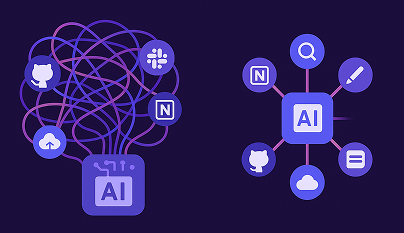
A Deep Dive: Lunar.dev vs. Traditional API Solutions
In this article, we’ll take a closer look into Lunar.dev, a cutting-edge Management Platform to Optimize 3rd Party API Usage end to end, versus some older and traditional solutions like RapidAPI. Lunar.dev introduces an Egress API-Proxy, incorporating a user-friendly interface with CLI experience, and integrating configurable policy-plugins to streamline API consumption without extra coding or middleware.
Distinctively, Lunar.dev is crafted for managing and optimizing third-party API usage at scale, aiming to cut costs and uphold performance seamlessly.
Lunar.dev vs. The Traditional API Marketplaces
What are API Marketplaces?
API marketplaces like RapidAPI are hubs where developers discover and integrate various APIs. They ease the process of connecting developers to a multitude of APIs across different sectors.
While often the API marketplaces require you to wrap all your external calls with their specific SDKs, Lunar.dev’s approach is light-weight and flexible. Lunar.dev's emphasis on seamless integration, broader SDK support, and enhanced observability present a refined approach to managing and optimizing API consumption, setting it apart in the crowded API management arena.
Lunar.dev vs RapidAPI Example: The Differentiators
- Optimization: Lunar.dev is engineered to minimize usage costs and bolster the resilience and scalability of external API integrations, whereas RapidAPI primarily aids in the easy integration and initial usage of APIs.
- SDK Adaptability: RapidAPI requires its SDK for API interaction, possibly limiting the functionality of these APIs. Lunar.dev, on the other hand, supports all API integrations or official SDKs, maintaining the original functionality by channeling API traffic from existing integrations.
- Observability: While RapidAPI provides basic visibility into API utilization, Lunar.dev extends deeper observability, highlighting usage patterns, and pinpointing inefficiencies and anomalies.
With lunar.dev it becomes easier to scale your API usage and it’s dedicated to ensure flawless performance that does not harm performance.
Lunar.dev vs. API Gateways
What do API gateways do?
API Gateways serve as intermediaries in companies that provide APIs, managing and routing API calls to the appropriate services within the backend infrastructure while offering features such as rate limiting, security, and analytics, thereby encapsulating the internal architecture and ensuring a streamlined, secure, and monitored API provision to external or internal consumers.
They facilitate the interaction between clients and various services, enabling companies to offer more robust and user-friendly API interfaces.
Lunar.dev vs Kong Example: The Differentiators
Kong serves the necessities of API providers and not the consumers like lunar.dev, ensuring streamlined, secure, and monitored API provision to both external and internal consumers. Worth noting, that the market is also populated with other notable API Gateway solutions like Mulesoft, Tyk, Apigee, Axway, and KrakenD, each with distinct capabilities catering to the diverse needs of API providers.
Kong orchestrates, configures, and routes requests to APIs. It's a centralized solution catering to the DevOps realm, streamlining the flow of ingress API traffic from consumers to a company's backend.
Lunar.dev, however, embarks on a different trajectory, emphasizing the optimization and management of egress API traffic from companies to external APIs. It's a unique solution, mirroring traditional API gateways but with a focus on serving developers responsible for API integration and optimization.
- Code Changes: Traditional API gateways like Kong necessitate code changes for deployment. In contrast, Lunar.dev requires no code alterations. Users simply import the interceptors and proxy containers, and can start gaining value like detection and real-time resolution, with an option for agentless operation.Using Kong for external API usage is possible but it will take huge development efforts to achieve.
- API Traffic Orientation: While Kong manages ingress traffic, Lunar.dev specializes in controlling and regulating egress API traffic, offering a streamlined approach to external API usage.
- Architecture: Unlike the centralized architecture of Kong, Lunar.dev adopts a distributed model leveraging micro-proxy concepts. It positions interceptors across distributed backends, tunneling traffic to micro API-proxies based on traffic loads or other specified criteria.
- Target Audience: Kong finds its place in the DevOps toolbox, while Lunar.dev is tailored for Architects, developers and managers who delve into API integrations, understand the business logic of API usage, and bear the mantle of managing and optimizing traffic.
- Security and Resilience: Lunar.dev not only optimizes but also aims to secure and fortify the API egress traffic, ensuring a resilient interaction with external APIs.
- Code Changes: Traditional API gateways like Kong necessitate code changes for deployment. In contrast, Lunar.dev requires no code alterations. Users simply import the interceptors and proxy containers, and can start gaining value like detection and real-time resolution, with an option for agentless operation.
In essence, Lunar.dev emerges as a complementary solution to traditional API gateways like Kong, carving a niche in catering to developers and focusing on egress traffic management. Its distinctive approach offers a new way for companies to interact with external APIs, shedding light on the untapped potential of meticulous egress API traffic management as well as being failsafe by design.
Lunar.dev vs Service Meshes
What do service meshes do?
A Service Mesh is a dedicated infrastructure layer built to handle service-to-service communication in a transparent and reliable manner within microservices architectures. It provides a range of capabilities such as discovery, load balancing, failure recovery, metrics, and monitoring but is generally harder to implement entailing longer processes.
Lunar.dev vs Istio Example: The Differentiators
Istio is an open-source service mesh that facilitates the discovery, load balancing, traffic management, and security controls for distributed microservices, enabling a robust, observable, and reliable infrastructure with enhanced control and observability without requiring changes to the existing service code.
- Traffic Focus: While Istio is geared towards internal communication between backend microservices, Lunar.dev emphasizes on managing egress traffic to external APIs.
- Deployment Overhead: Deploying a service mesh like Istio entails a substantial setup overhead. Conversely, Lunar.dev is designed for simplicity in both installation and removal, requiring merely a container installation and API traffic wiring from backend services, with options for agent or agentless deployment.
- Target Audience: Service meshes cater to DevOps professionals aiming to fine-tune internal microservices communications. Lunar.dev, however, is Architect aimed or developer-centric, with tools for managers to handle and optimize external API interactions based on each companies’ unique business logic.
- Layer of Operation: Istio operates at the network layer, managing traffic flow. Lunar.dev operates at the application layer, focusing on API traffic with offerings to control, orchestrate, and optimize API interactions, aligning them with unique business logic.
.png)
Hence, while both Istio and Lunar.dev aim to streamline traffic management, their focal points and operational layers distinctly differ. Lunar.dev’s egress traffic management, simple deployment, and application layer operation make it a unique solution, tailored for companies keen on refining their external API interactions and scaling their 3rd party API usage efficiently.
To conclude
In drawing a conclusion from the diverse landscapes of API solutions explored, Lunar.dev emerges with a distinct posture, carving its category as management and optimization of 3rd party API usage. Here for the first time, the company using the API and their client is at the forefront and not the API providers.
While conventional platforms like RapidAPI, Kong, and Istio cater to a range of needs from easing API integration, managing internal microservices communication to orchestrating ingress API traffic, Lunar.dev shines in its exclusive focus on orchestrating and optimizing egress traffic to external APIs.
This unambiguous focus renders Lunar.dev as a pivotal asset for entities keen on elevating the scalability, resilience, and performance of their external API interactions. Lunar.dev is failsafe by design and can intercept HTTPS/TLS traffic without code changes. Lunar.dev’s egress traffic management, simple deployment, and application layer operation make it a unique solution, tailored for companies keen on refining their external API interactions and scaling their 3rd party API usage
As you can see, there are many issues that API consumers can face. If you want to manage your 3rd party API consumption with no sweat, consider giving Lunar.dev a try!
Try out our Sandboxes (fully free, no need to enter any credentials)
Or check out the documentation and OSS Repo
Ready to Start your journey?
Manage a single service and unlock API management at scale






